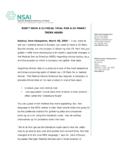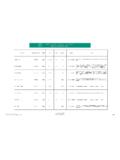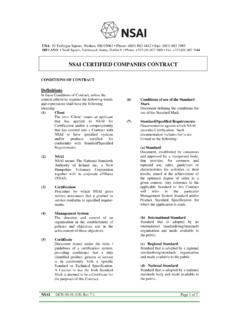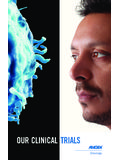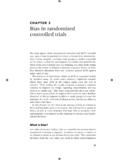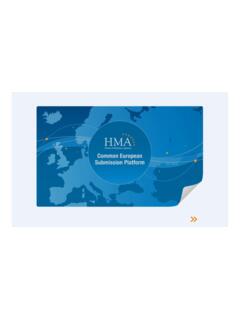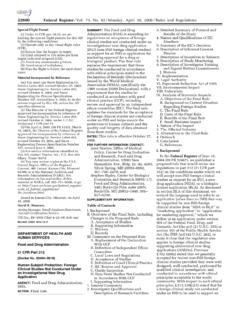Transcription of DON’T NEED A CLINICAL TRIAL FOR A CE MARK? THINK AGAIN
1 DON T NEED A CLINICAL TRIAL FOR A CE MARK? THINK AGAIN Nashua, New Hampshire, March 30, 2009 If you want to sell your medical device in Europe, you need to have a CE Mark. Sounds simple, but the process of obtaining that CE Mark has just gotten a little more challenging with recently approved changes to the Medical Device Directive (MDD) regarding CLINICAL testing data and the process by which a company can gather that data. Acquiring CLINICAL data on a product is one of the most expensive and time-consuming parts of obtaining a CE Mark for a medical device. The Medical Device Directive has required a company to provide CLINICAL data on its new product in one of two ways: Conduct your own CLINICAL TRIAL Use equivalent CLINICAL data from another similar product - often called the Literature Route You can guess which method has more appealing. But new language in the MDD makes it clear that CLINICAL trials are going to be the preferred method for gathering data and companies banking on only using the literature route, may be setting themselves up for problems down the road.
2 While at first glance the literature route seems like the better way to go due to less cost and quicker turn around time, this has changed with the new MDD language, says Dr. John O Dwyer, European Manager Medical Devices and CLINICAL Director of Medical Devices with the National Standards Authority of Ireland (NSAI), which is a Notified Body specializing in medical device certifications. As member of the EU working group that updated the Medical Device Directive, I can say that it s going to be tougher to use published data under the new MDD which takes effect next March, but is starting to be applied now. The new language clearly states that CLINICAL trails for high-risk classifications shall be performed unless duly justified. This is a significant change from the language in the current version of the directive. In the last few weeks I ve had a number of clients that provided me with data which they hoped would allow them to use equivalent data to certify their product, but in light of the new rules I had to tell them the CLINICAL data route was ill advised, says Claire McKenna, Medical Devices Program Manager with NSAI.
3 Novel and unique attributes of new products will now require unique CLINICAL investigations. For example, one of my clients was trying to get a CE Mark for a product used to repair a knee joint damaged by osteoarthritis. They found that a product that was already on the market that also targeted knee joints damaged by osteoarthritis and figured they were all set. But on a closer look, the products were very dissimilar. For one thing they anchored to the bones whereas the device they cited required the physician to cut the bone. The systems were completely different. Yet the company thought it was comparing apples to apples. The new language may be a blow to companies trying to use the literature route for certification. But if you THINK about it, CLINICAL trials do make more sense. In order for a company to use existing data to support their product, their new product has to be significantly similar to the product from which the test data originates.
4 In other words, the new product has to basically be the same as the existing product and we all know that in the medical device market place, this is not always the formula for success. McKenna says using literature isn t impossible. More often she predicts companies will use literature to supplement parts of their application. To determine if literature can be used, McKenna compares the product to three benchmarks: Technical: We first look to see if the physical make up of the product is similar to the cited CLINICAL data, she says. The technical data has to be very similar in order for the citation to work. The size, shape, the methods used to design it, how it is deployed, its color, durability, etc. all need to compare equally. If your product is close but maybe 10mm longer than the product you are trying to reference, the equivalency test may not work. Biological This is a very critical area and covers how the product interacts with the human body, says McKenna.
5 Are the product s materials established and proven to be compatible with the human body? For example, if the product is made of titanium, your reference product must be also. However if you ve updated your product from titanium to a new polymer, you cannot go the literature route and will need to collect new biological test data in a CLINICAL TRIAL . CLINICAL Equivalency The last area that is examined is how the device will affect the end user. Does your product have the same identified end users, same instructions and is used in the same anatomical area as the referenced product? Is it put in or on the body through the same access point? Are the physician instructions similar and is the product used in the same fashion? There are many areas where products can differ, says McKenna. Your product may be similar to the product you are comparing from a technical and biological sense, but if your new product is made for children and the equivalent product is used by seniors, you may need to collect CLINICAL equivalency data in new trials.
6 So you might be wondering to yourself, the regulations seem so tight. Is the literature route even possible? Often you have a combination of equivalency data and new CLINICAL TRIAL data to make the application solid, says O Dwyer. One of our recent cases offers a good example of that. A client manufactured a stent that was used in one part of the body and wanted to transfer this piece for use in a product that would be used in a different area. We were able to reference the existing data on the stent for the technical and biological areas of equivalency, but the client had to conduct its own TRIAL to gather data to satisfy the CLINICAL part of the equation. They were still able to save time and money but couldn t just use published literature to support all aspects of the new device s CE Mark application. O Dwyer says the best solution for a company wondering how they should go about collecting data on their new device is to talk to their Notified Body early in the product development process.
7 In fact NSAI has been providing pre-submission regulatory guidance services to their clients for this exact reason. Nothing is worse than a company coming to us with a completed application and thinking that they are able to utilize data from another product, says O Dwyer. They THINK they are only a matter of weeks away from a CE Mark, only to find that they need to collect additional CLINICAL data which may add a significant amount of time to get their product to market. My advice is that if you re in the process of developing a new product, start talking to your Notified Body and find out what data will meet the requirements of the directive. McKenna says she s not surprised to see the changes and is advising all of her clients to take heed. If you THINK about it, it only makes sense. Medical Devices are often high-risk propositions and a company needs to protects its patients and itself by doing due diligence through unique CLINICAL trials, she concludes.
8 While there will be cases where the equivalency route can still work, it will be rare and companies shouldn t bank on avoiding a CLINICAL TRIAL . About NSAI For over 50 years, the National Standards Authority of Ireland has been offering a full range of services relating to Management Systems Standards and Certification Services throughout the world. The company specializes in medical device, aerospace and environmental certifications. For more information visit or call 603-882-4412. -end.
